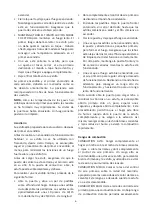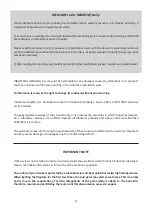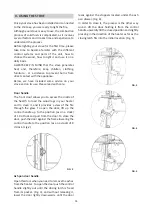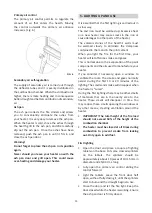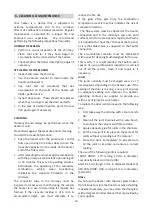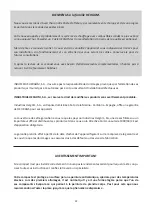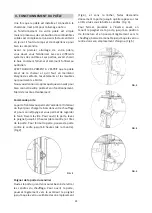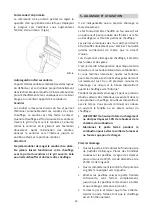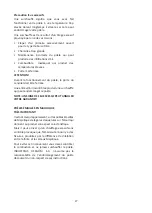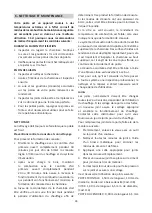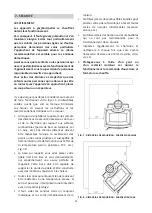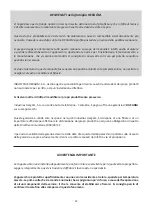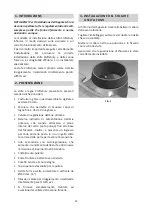
18
6 - CLEANING & MAINTENANCE
Your heater is a device that is subjected to
extreme temperatures and to the corrosive
effects of combustion residual materials. Regular
maintenance is essential for a longer life and
improved user experience. We recommend
performing the following inspections frequently.
DURING THE SEASON
• Perform a visual inspection of the chimney.
Clean soot and tar if they have begun to
accumulate on the inner walls of the heater.
• Check whether the doors close tightly; adjust if
necessary.
AT THE END OF THE SEASON
• Inspect and clean the chimney.
• Use the vacuum cleaner to clean inside the
heater and inspect it.
• Any soot and tar (creosote) that has
accumulated on the walls of the heater will
hinder performance.
• Inspect door seals. These should be replaced
when they no longer seal the door perfectly.
• In the case of painted heaters, paint the cast
iron parts again if necessary
CLEANING
Cleaning should always be performed when the
heater is cold.
Preventions against the creosote and its cleaning
To avoid the creosote formation:
• Keep the heater with the primary air control
fully open during 30 minutes daily to burn the
creosote deposited in the inside of the heater
and of the flue system.
• After reloading the wood, keep the combustion
with the primary air control fully open during 20
or 30 minutes. This way of operating ensures,
beforehand, the operating of the secondary
combustion,
which,
when
functioning,
minimises the creosote formation in the
chimney.
The connector tube to the chimney must be
inspected at least every month during the season
the heater is in use to determine if creosote has
formed. If the creosote residue is of 6 mm in
accumulated depth, you must eliminate it to
reduce the fire risk.
If the glass often gets dirty, the combustion
temperature level is low; this indicates the risk of
creosote formation.
The flue system must be checked at the heater
connection and in the chimney’s top end. Cold
surfaces tend to create deposits rapidly, that’s why
it is important to check the chimney at the top end,
as it is the coldest area, as opposed to the heater
connection.
The accumulated creosote must be eliminated
with a specific cleaning brush designed for this use.
This is why it is recommended that before each
season of use a professional inspection is carried
out of all the system, clean it and repair it, if
necessary.
Joints
The joints normally must be changed every 2 or 3
used seasons, depending on the heater’s use. If the
sealing of the door is missing, a new joint ensures
an adequate sealing and improves the heater’s
operating. Contact your supplier to provide you
with a set of joints for your heater.
To replace the door joints proceed in the following
way:
1. First take away the old one with a tool or knife
tip.
2. Clean all the joint channels with a wire brush,
to eliminate the cement and fibre residue.
3. Apply adequate glue for joints in the channels.
4. Put the new joint in its place on the cement for
joints without spreading out the material.
5. Close the door immediately to put pressure
on the joint in its place and ensure a correct
sealing.
The use of the following joints is required:
FRONT DOOR: 1.70 m long, 10 mm in diameter.
Low density black cord (Code J38)
GLASS: 1.50 m long 6.5 mm. In diameter (Code J14)
ASH PAN DOOR: 0.90 m long 6.5 mm in diameter.
(Code J14)
Glass
Do not use the heater with the door glass broken.
Do not knock or slam the front door when shutting.
If deemed necessary, you may clean the door glass
with a Hergóm Window Cleaner that is provided by
your supplier.
Summary of Contents for CRAFTSBURY
Page 52: ...52 8 DIMENSIONES DIMENSIONI MEASURES DIMENSIONS DIMENSÕES ...
Page 55: ...55 10 DESPIECE ESPLOSO EXPLODED VIEW EXPLOSÉ EXPLODIDO ...
Page 58: ...58 ...
Page 59: ...59 ...



